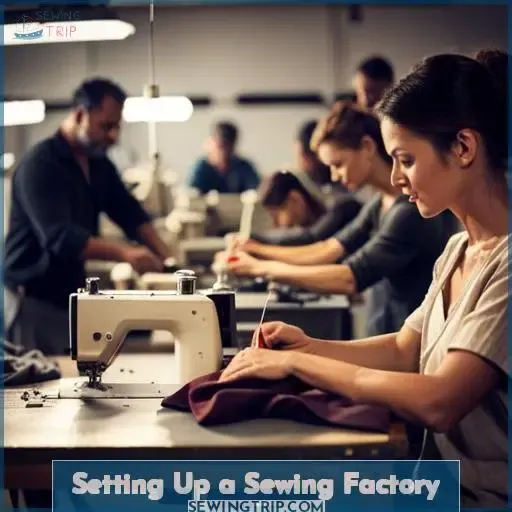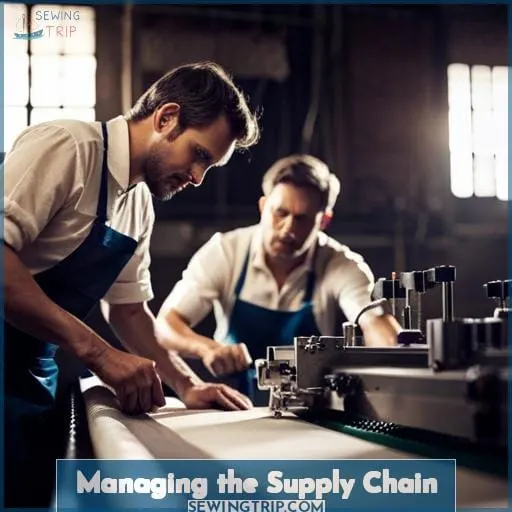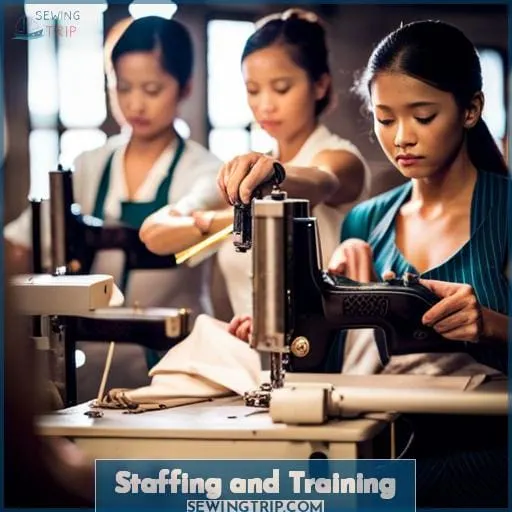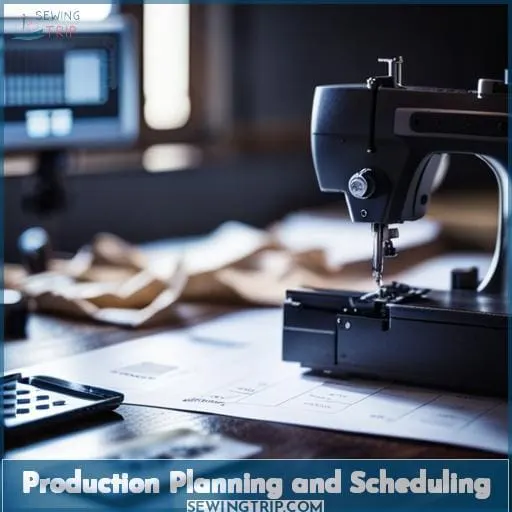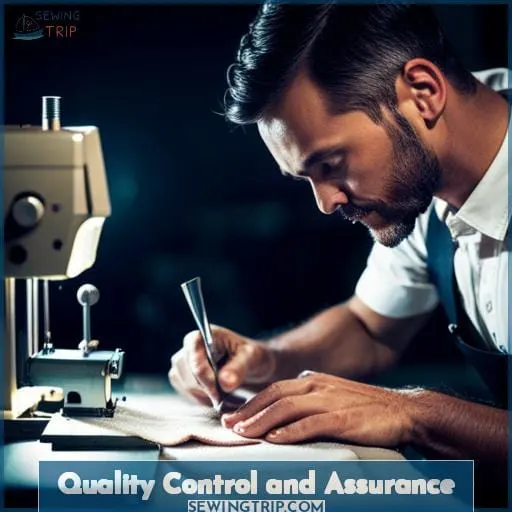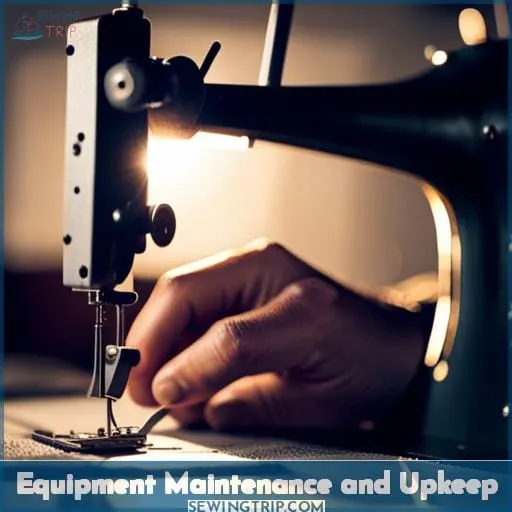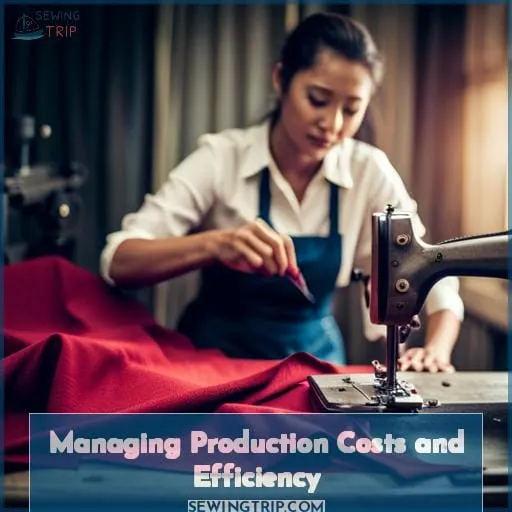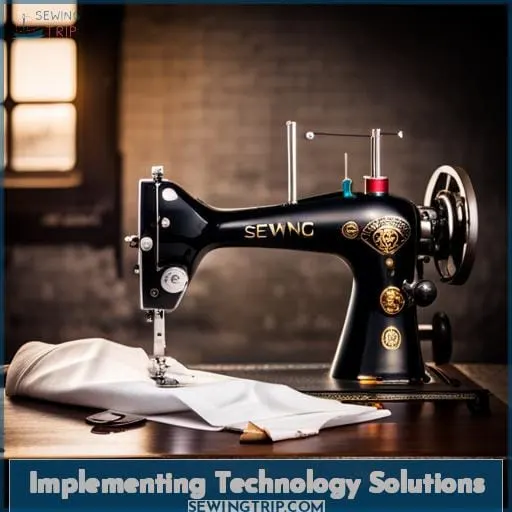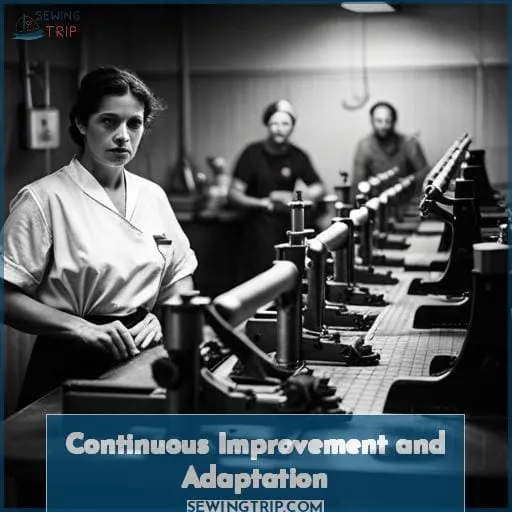This site is supported by our readers. We may earn a commission, at no cost to you, if you purchase through links.
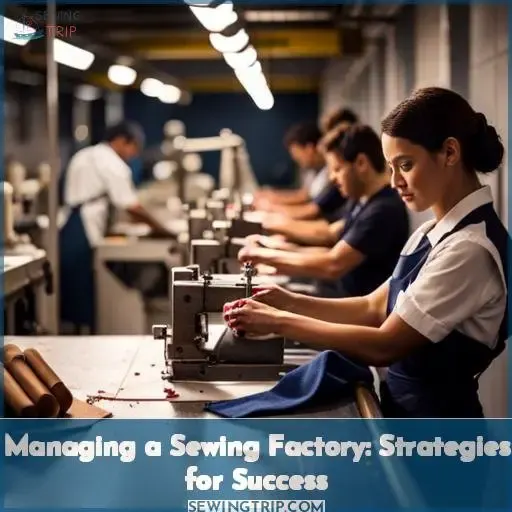 Imagine running a sewing factory that operates like a well-oiled machine. You have the power to manage every aspect, from sourcing materials and staffing skilled operators to implementing lean manufacturing principles and utilizing technology solutions.
Imagine running a sewing factory that operates like a well-oiled machine. You have the power to manage every aspect, from sourcing materials and staffing skilled operators to implementing lean manufacturing principles and utilizing technology solutions.
With your expertise, you can ensure efficient production planning, quality control, equipment upkeep, and cost management.
In this article on managing a sewing factory for success, discover strategies that will empower you to take control of your operations and achieve optimal results.
Table Of Contents
- Key Takeaways
- Setting Up a Sewing Factory
- Managing the Supply Chain
- Implementing Lean Manufacturing Principles
- Staffing and Training
- Production Planning and Scheduling
- Quality Control and Assurance
- Equipment Maintenance and Upkeep
- Managing Production Costs and Efficiency
- Implementing Technology Solutions
- Continuous Improvement and Adaptation
- Frequently Asked Questions (FAQs)
- Conclusion
Key Takeaways
- Allocate sufficient space and invest in high-quality equipment for different production processes.
- Prioritize fabric quality, lead time, cost-effectiveness, sustainability, and ethical sourcing in supply chain management.
- Hire skilled sewing operators, provide regular training, and offer competitive salaries and benefits.
- Set clear quality standards, conduct regular inspections and audits, and take prompt corrective actions on any issues found.
Setting Up a Sewing Factory
When setting up a sewing factory, you’ll need to carefully consider and plan for the necessary equipment, space, and resources.
The layout of your sewing factory is crucial in ensuring smooth operations and efficient workflow. It’s important to allocate sufficient space for different production processes such as cutting, sewing, finishing, and packaging.
Additionally, investing in high-quality equipment for your sewing factory is essential in achieving optimal productivity and garment quality. This includes industrial-grade sewing machines, cutting tables with proper lighting and marking tools, and pressing irons or steamers.
Keep in mind that the cost of setting up a sewing factory can vary depending on factors like location, equipment selection, and labor costs.
To effectively manage your new facility, you should also provide comprehensive training programs to ensure that all employees are skilled in their roles and understand the operational procedures.
Managing the Supply Chain
When managing the supply chain in a sewing factory, sourcing materials and inventory management are crucial aspects to consider.
Sourcing materials involves finding reliable suppliers who can provide high-quality fabrics and other necessary components for garment production.
Effective inventory management ensures that you have the right amount of raw materials on hand, minimizing stockouts or excess inventory.
By strategically managing your supply chain, you can ensure smooth operations and timely delivery of finished products to meet customer demands efficiently.
Sourcing Materials
How do you ensure a reliable supply of quality materials for your sewing factory at the best possible prices?
Establishing relationships with reputable suppliers and implementing strong inventory management practices are key to efficiently managing your supply chain.
By prioritizing fabric quality, lead time, cost-effectiveness, sustainability, and ethical sourcing, you can ensure that your materials meet both industry standards and customer expectations.
Effective communication with suppliers and utilizing garment manufacturing software for inventory management and forecasting will further optimize your sourcing process.
Inventory Management
Before you can begin production, you’ll need to get a handle on managing your inventory of raw materials, fabrics, and other supplies.
- Carefully track inventory turnover, reorder points, and safety stock levels to ensure adequate materials while minimizing excess inventory.
- Streamline lead times with suppliers and aim for just-in-time delivery to reduce the amount of working capital tied up.
- Implement strict inventory management protocols around marking, cutting, production, and sizing to maximize material efficiency.
Implementing Lean Manufacturing Principles
You can streamline your production process by:
- Identifying and eliminating any non-value-added activities
- Focusing on continuous flow
- Improving upon your lean practices
Implement visual controls like balancing charts to easily spot bottlenecks.
Conduct cycle checking to balance operator workloads under the takt time.
Address bottleneck stations through work redesign or adding operators.
Cross-train employees and use multi-skilled teams to fill gaps.
Standardize procedures to minimize waste.
Incorporate small batch processing and single-piece flow.
Continually reinforce the lean culture through training and employee involvement in kaizen events targeting reduced lead time, improved quality, and faster product development.
With smarter layouts, balanced work, standardized operations, and an empowered workforce, you’ll maximize manufacturing velocity, quality, and flexibility.
Staffing and Training
When managing a sewing factory, one of the key strategies for success is to focus on staffing and training.
Hiring skilled sewing operators who’ve experience and expertise in garment production is crucial to ensuring efficient operations.
Additionally, providing ongoing training and development opportunities for your staff can help them stay updated with the latest techniques and technologies in the industry, ultimately enhancing their productivity and improving overall factory performance.
Hiring Skilled Sewing Operators
To ensure the success of your sewing factory, it’s crucial to hire skilled sewing operators who possess the necessary expertise and experience.
- Post job listings on industry job boards and apprenticeship programs to find candidates with training from trade schools or existing roles.
- Offer competitive salaries, benefits, and retention bonuses.
- Invest in ongoing training and certification programs to continually develop employee skills, reduce turnover, and promote long-term retention.
Providing Ongoing Training and Development
Two can ensure skilled operators by providing regular training sessions to maintain and build upon existing skills, as well as offer development opportunities to take on more responsibilities.
Implement various training methods such as hands-on workshops, online courses, and mentorship programs.
Consider the frequency of training sessions based on the needs of your staff and industry trends.
Ensure that the content of the training is relevant to garment design, pattern making, apparel design, and other key areas.
Evaluate the effectiveness of your training programs through assessments and feedback from participants.
Measure your return on investment (ROI) by tracking improvements in productivity and quality after implementing training initiatives.
Production Planning and Scheduling
Effective scheduling of the manufacturing process keeps your workflows running smoothly.
- Identify bottleneck operations:
- Analyze your production line to pinpoint any operations that slow down the overall workflow.
- Address these bottlenecks by allocating additional resources or streamlining processes.
- Cycle checking:
- Regularly monitor cycle times for each operation to identify areas where productivity can be improved.
- Adjusting workloads or providing additional training can help optimize cycle times and eliminate inefficiencies.
- Takt time:
- Determine the ideal pace at which products should be produced to meet customer demand while maintaining high quality standards.
- Line balancing and balancing charts:
- Use visual tools like balancing charts to analyze work methods, identify non-value-added activities, and achieve optimal balance across different tasks on the assembly line.
Quality Control and Assurance
You need to set clear quality standards that each garment must meet before leaving your factory.
Regular inspections and audits should then be conducted at multiple stages of production to catch any defects early.
By closely monitoring quality at all levels, you can ensure your finished products consistently meet customer expectations.
Setting Quality Standards
You’d be stitching up trouble if you didn’t establish clear quality standards that align with customer expectations before getting underway with production.
Define tolerances for product defects and document quality control procedures for detecting issues during manufacturing.
Create size charts, grading rules, and tech packs outlining specifications so that everyone understands the standards to which finished garments must conform.
Conduct quality assurance through documentation, grading, inspections, and by training staff on procedures.
Conducting Inspections and Audits
To ensure the highest quality standards are met, it’s crucial that you regularly conduct inspections and audits in your sewing factory.
Establish frequency of inspections, types of inspections, detailed checklists, and thorough documentation.
After inspections, take prompt corrective actions on any issues found.
Continual vigilance through robust inspections and audits will help uphold impeccable quality.
Equipment Maintenance and Upkeep
Now that you have established a strong foundation for quality control and assurance in your sewing factory, it’s crucial to shift your focus towards equipment maintenance and upkeep.
Maintaining the functionality of your machinery is essential to ensure smooth operations and prevent costly downtime. Regular inspections, preventive maintenance, and regular upkeep are key practices that should be incorporated into your daily routine.
Create a comprehensive maintenance schedule outlining when each piece of equipment needs servicing or inspection. This will help you stay organized and proactively address any potential issues before they escalate into major problems.
Additionally, make sure to keep an inventory of spare parts readily available so that replacements can be made promptly if necessary.
By prioritizing equipment maintenance and implementing proper upkeep procedures in line with industry best practices, you can optimize the lifespan of your machines while minimizing disruption to production processes in the sewing factory environment.
Managing Production Costs and Efficiency
When it comes to managing production costs and efficiency in your sewing factory, monitoring key production metrics is essential.
By closely tracking metrics such as labor productivity, machine downtime, and material waste, you can identify areas of inefficiency or waste that need improvement.
Once these areas are identified, implementing strategies to eliminate waste and streamline processes will help optimize the overall cost-effectiveness and efficiency of your factory operations.
Monitoring Production Metrics
When it comes to managing your production costs and efficiency, you’ll want to keep close tabs on metrics like:
- Labor hours per garment
- Fabric utilization
- Inventory turns
You can use garment manufacturing software or manual tracking to do this.
Monitoring cycle time, takt time, bottleneck operations, and balancing your line input versus output can help supervisors identify and address inefficiencies through cycle checking and other continuous improvement methods.
Tracking these production metrics is key for garment manufacturers looking to maximize quality and profitability.
Identifying and Eliminating Waste
While manufacturing garments, you’ll find yourself looking to eliminate any unnecessary costs that reduce your operation’s profit.
By monitoring takt time and required output, you can identify bottleneck operations with excess work content.
Use cycle checking and balancing charts to streamline these areas.
Target finishing, pattern drafting, sample making, and labeling that don’t directly contribute value.
Optimizing your process flows boosts efficiency and positions you competitively in the $826 billion global garment manufacturing market.
Implementing Technology Solutions
Look into adopting garment manufacturing software and automation where possible. This can greatly improve your workflow efficiency and quality control.
Carefully weigh the costs versus benefits before investing in new technologies like robotics for your factory.
Adopting Garment Manufacturing Software
You’ll want to adopt garment manufacturing software after monitoring production metrics and identifying waste to further optimize operations in your sewing factory.
Garment manufacturing software brings numerous benefits, including:
- Improved productivity
- Streamlined workflow
- Accurate inventory management
- Enhanced quality control
However, there are also challenges such as:
- The initial cost of implementation
- Employee training
Different types of garment manufacturing software are available in the market with varying costs and features. Ultimately, investing in the right software can provide a significant return on investment for your clothing design or fashion design business.
Using Automation and Robotics
To optimize efficiency and productivity in your sewing factory, incorporate automation and robotics into your production processes.
Automation provides clear benefits like improved quality and lower costs, but also poses challenges like high upfront investments.
Carefully evaluate types of automation like automated material handling and robotic sewing to determine what solutions fit your factory now.
Though automation adoption can be difficult initially, the future is moving rapidly toward automated garment manufacturing, so get ahead of the curve.
Continuous Improvement and Adaptation
Now that you have implemented technology solutions to streamline your operations, it’s time to focus on continuous improvement and adaptation. This subtopic is crucial for staying ahead in the ever-changing garment manufacturing industry.
By embracing change management and involving your employees in the process, you can foster a culture of innovation and problem-solving within your sewing factory.
Here are some key strategies for continuous improvement and adaptation:
- Implement kaizen principles: Encourage small, incremental improvements in every aspect of your production process.
- Foster employee involvement: Empower your team members by giving them opportunities to contribute their ideas for process improvement.
- Regularly evaluate processes: Continuously analyze each step of the manufacturing workflow to identify areas where efficiency can be enhanced.
- Embrace problem solving: Create a system where issues or bottlenecks are promptly addressed through collaborative problem-solving techniques.
By actively seeking ways to improve processes, involve employees at all levels, and embrace change as an opportunity rather than a challenge.
Frequently Asked Questions (FAQs)
What are some common challenges faced when managing a sewing factory?
Managing a sewing factory comes with challenges such as:
- Maintaining line balance
- Addressing bottleneck operations
- Monitoring input vs. output
Streamlining operations, improving supply chain management, and implementing lean manufacturing techniques can help overcome these challenges for greater efficiency and profitability.
How can I ensure efficient production planning and scheduling in my sewing factory?
To ensure efficient production planning and scheduling in your sewing factory:
- Analyze workflow bottlenecks
- Streamline operations
- Implement lean manufacturing principles
Utilize garment manufacturing software to:
- Manage inventory
- Track quality control metrics
What are some strategies for effectively managing production costs and improving efficiency in a sewing factory?
To effectively manage production costs and boost efficiency in your sewing factory, focus on:
- Streamlining operations
- Optimizing supply chain management
- Negotiating shorter lead times with suppliers
Implement lean manufacturing principles and utilize garment manufacturing software for better planning and inventory management.
How can I implement technology solutions in my sewing factory to enhance productivity and streamline operations?
To enhance productivity and streamline operations in your sewing factory, implement cutting-edge technology solutions.
These powerful tools will revolutionize your production process, giving you unprecedented control and efficiency that will propel your business to new heights of success.
What are some key factors to consider when continuously improving and adapting a sewing factory’s processes and practices?
Consider workflow, capacity, quality control, and staff skills.
Continuously monitor operations to identify bottlenecks.
Implement small iterative changes, engage staff in problem solving, and invest in developing multi-skilled teams.
Rapidly test modifications before full deployment.
Urge ownership and empower suggestions from the factory floor.
Conclusion
To successfully manage a sewing factory, you must embody the adage “measure twice, cut once.” By implementing strategies such as efficient supply chain management, lean manufacturing principles, and continuous improvement, you can ensure optimal results in your operations.
Hiring skilled operators, maintaining equipment, and utilizing technology solutions will further enhance productivity and efficiency. With your expertise, you can achieve success in managing a sewing factory and maximize production output while maintaining quality standards.

